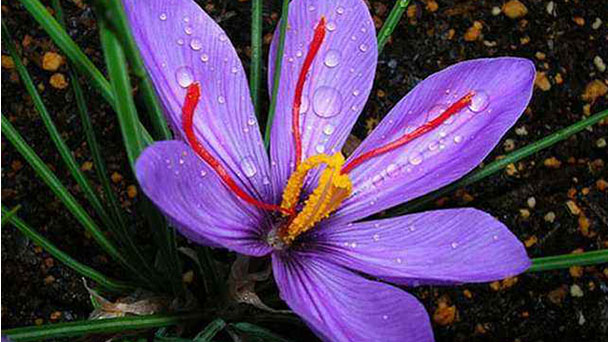The breeding methods and precautions of Crocus sativus L
Written by Maggie
Nov 21 2020

Crocus sativus L can be kept under astigmatism during cultivation. Usually every 3 ~ 5 days of water, every 10 ~ 15 days of nitrogen phosphate fertilizer. When the leaves turn yellow and wither in Spring of each year, saffron can be taken out from the soil to plant the ball. In autumn, they are replanted in the saprolite soil. Keep the temperature above 5℃ in winter.
Crocus sativus L picture

Crocus sativus L farming methods
1. Get plenty of light
Crocus sativus L has strong shade tolerance. But prolonged exposure to light can cause Crocus sativus L's leaves to gradually color, and may even prevent them from producing beautiful flowers. Therefore, it can be kept under astigmatism in normal times, which can promote the differentiation of branches and leaves of Crocus sativus L and make it produce beautiful flowers.
2. Water in time
Crocus sativus L needs plenty of water to grow. Water the soil once a year before breeding. Usually it needs to water every 3 ~ 5 days. It is best to control the amount of watering in winter, otherwise the plants will be easily frostbitten. Water can be watered every 10 days.
3. Apply fertilizer rationally
In fact, proper fertilization is very important in Crocus sativus L cultivation methods and precautions. Every time saffron is propagated, the best amount of base fertilizer is applied to the soil. Nitrogen and phosphorus should also be applied every 10 to 15 days during the growth process. Fertilization can be avoided in winter, which helps Crocus sativus L grow.
4. Seed breeding
In the breeding process of Crocus sativus L, the leaves and leaves of Crocus sativus L gradually turn yellow and wither in the spring from April to May every year. We need to take the seed balls out of the soil. The rotten part in a timely manner to deal with, can be used in yarn bags or silt soil preservation. Wait until the fall to repot saffron pellets in leaf mould.

Notes for farming Crocus sativus L
1. Water and fertilizer management
Although Crocus sativus L needs plenty of water, don't overwater it at a time. You don't need watering on rainy days. The fertilizer should not be too thick, otherwise Crocus sativus L will grow in vain, and may even burn the roots to make it unable to grow normally. It is necessary to pay attention to the cultivation of Crocus sativus L.
2. Keep warm in winter
Crocus sativus L generally likes to grow in a warm and humid environment. It grows better at 15 ~ 20℃. But Crocus sativus L is not hardy. So the temperature must be controlled above 5 in winter, otherwise it is easy to frostbite the root of the plant, so that it does not open a beautiful flower, or even the whole plant wither and die.

Latest Updated
- Benefits of Bugleweed - 7 Science-backed Health Benefits
- Bugleweed Dangers & Side Effects - Is It Poisonous?
- How to Plant Evergreen Trees - What You Should Know
- When to Plant Evergreens - Grow Guide for Evergreen Trees
- 12 Wonderful Evergreen Shrubs for Your Garden
- 12 Popular Evergreen Plants with Pictures for Beginners
- When And How To Prune A Lilac Bush Like a Pro
- How to Grow & Care for Lilac Vine (Hardenbergia Violacea)
- Japanese Lilac Tree (Syringa Reticulata) Care & Propagation Guide
- Shumard Oak Pros and Cons - What to Know
Popular Articles
- Winter maintenance of Antirrhinum Majus
- How to Grow Terminalia Mantaly Tree
- How to Grow and Care for Crossostephium Chinense
- How to grow Antirrhinum Majus in spring
- Peristeria Elata (Dove Orchid) Profile: Info & Care Guide
- Underwatered Snake Plant (Sansevieria Trifasciata) - Signs And How To Fix
- How to Care for Brazilian Jasmine Plant (Mandevilla Sanderi)
- How to Grow & Care for Graptopetalum Purple Delight in Summer
- Rosa Chinensis (China Rose): Plant Growing & Care Tips
- How to Care for Baby Sun Rose (Aptenia Cordifolia)